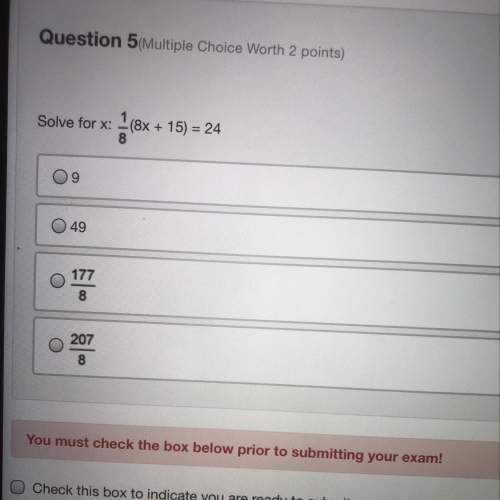
Mathematics, 15.12.2020 22:50 wj300
The figure below shows a quadrilateral ABCD. Sides AB and DC are equal and parallel:
A quadrilateral ABCD is shown with the opposite sides AB and DC shown parallel and equal.
A student wrote the following sentences to prove that quadrilateral ABCD is a parallelogram:
Side AB is parallel to side DC, so the alternate interior angles, angle ABD and angle CDB, are congruent. Side AB is equal to side DC, and DB is the side common to triangles ABD and CDB. Therefore, the triangles ABD and CDB are congruent by SAS postulate. By CPCTC, angles DBC and BDA are congruent and sides AD and BC are congruent. Angle DBC and angle BDA form a pair of vertical angles that are congruent. Therefore, AD is parallel and equal to BC. Quadrilateral ABCD is a parallelogram because its opposite sides are equal and parallel.
Which statement best describes a flaw in the student's proof?
Triangles ABD and BCD are congruent by the SSS postulate instead of the SAS postulate.
Triangles ABD and BCD are congruent by the AAS postulate instead of the SAS postulate.
Angle DBC and angle BDA form a pair of corresponding angles, not a pair of vertical angles.
Angle DBC and angle BDA form a pair of alternate interior angles that are congruent, not a pair of vertical angles.

Answers: 3


Another question on Mathematics

Mathematics, 21.06.2019 14:30
Find a number such that if you add 8 and divide the result by 4 you will get the same answer as if you subtracted 3 from the original number and divided by 2
Answers: 3

Mathematics, 21.06.2019 15:30
Which conjunction is disjunction is equivalent to the given absolute value inequality? |x+2|< 18
Answers: 1

Mathematics, 21.06.2019 16:30
Arandom sample of 150 high school students were asked whether they have a job. the results are shown in the table. have a job do not have a job male 48 35 female 41 26 select a ord or phrase from the drop-down menus to correctly complete the statements describing the association.
Answers: 1

Mathematics, 21.06.2019 16:30
Refer to the table below if needed. second quadrant third quadrant fourth quadrant sin(1800- - cos(180° -) tan(180°-e) =- tane cot(1800-0) 10 it to solo 888 sin(180° +c) = - sine cos(180° +) =- cose tan(180° +c) = tane cot(180° +o) = cote sec(180° + c) = - seco csc(180° +2) = - csce sin(360° -) =- sine cos(360° -) = cose tan(360° - e) =- tane cot(360° -) = -cote sec(360° -) = seco csc(360° -) = csco sec(180° -) = csc(180° -) = csca 1991 given that sine = 3/5 and lies in quadrant ii, find the following value. tane
Answers: 2
You know the right answer?
The figure below shows a quadrilateral ABCD. Sides AB and DC are equal and parallel:
A quadrilatera...
Questions


Social Studies, 05.01.2022 01:10

English, 05.01.2022 01:10

Medicine, 05.01.2022 01:10

Mathematics, 05.01.2022 01:10

Mathematics, 05.01.2022 01:10


Mathematics, 05.01.2022 01:10

Chemistry, 05.01.2022 01:10


Mathematics, 05.01.2022 01:10

History, 05.01.2022 01:10


SAT, 05.01.2022 01:10


SAT, 05.01.2022 01:10


Mathematics, 05.01.2022 01:10


SAT, 05.01.2022 01:10




